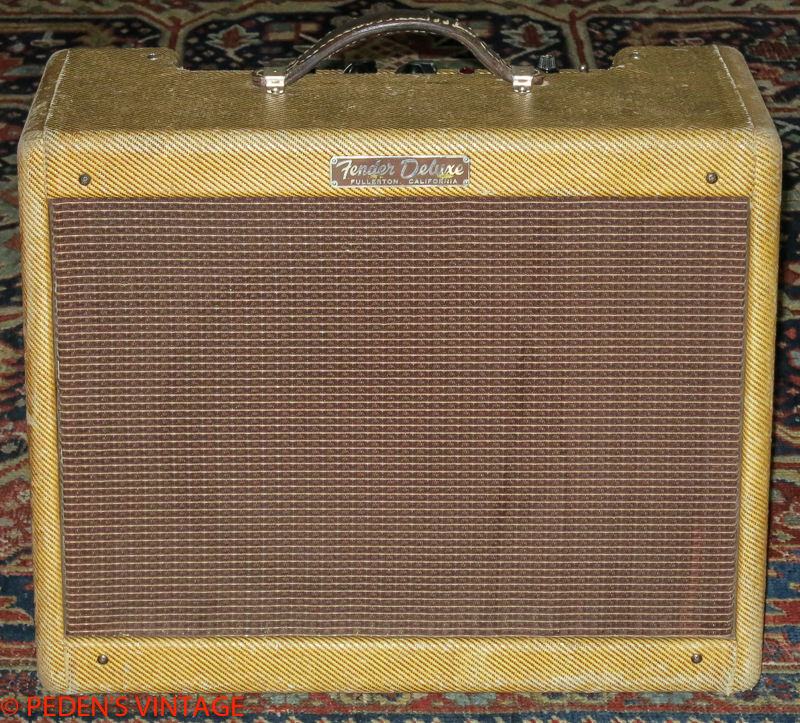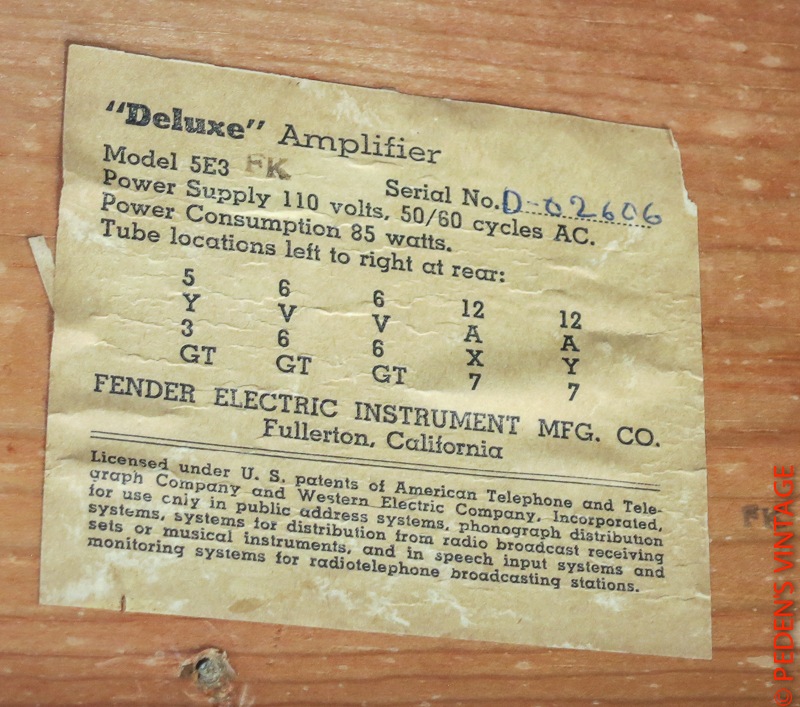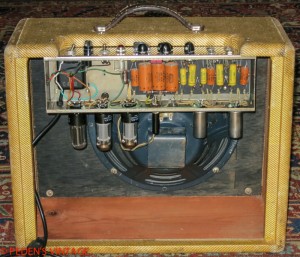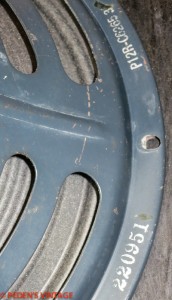Production years:
- 1955 -1960, 5e3 circuit
Tube layout
5e3 Tube layout (Seen from behind, V1 is to the right side)
- V1 12aY7 = Preamp normal and bright channel
- V2 12aX7 = Preamp normal and bright channel
- V3 6V6 = Power tube #1
- V4 6V6 = Power tube #2
- V5 5Y3GT = Rectifier tube
Summary
The 5e3 Deluxe belongs to the narrow panel tweed Fender era and was made between 1955 and 1960. They became collector items a long time ago and are rarely brought out these days to gigs by hobby or professional musicians. The physical condition of such old amps with tweed cotton tolex and leather handle will simply not allow that. Since the demand for these amps are bigger than the supply there are numerous amp builders today offering 5e3 Deluxe clone amps. Additionally, amp parts shops like Mojotone, TAD, Weber ++ offer clone kits for those you can build their own amp.
Let’s summarize the functions of the 5e3 Deluxe quickly:
- Two channels, normal and bright, each having their own volume control and a shared tone control. Each channel has the typical two inputs where nr 1 is a little louder than nr 2.
- Two 6V6GT power tubes operating in class AB push/pull mode, 5Y3 tube rectifier and 12AY7 and 12AX7 in the preamp section. Power rating is 15 watts.
- 1×12″ speaker, originally Jensen P12r or P12q.
- No negative feedback loop in the power amp section.
- Power tubes are cathode biased. Hence, no bias adjustment is required.
The 5e3 Deluxe is desirable among players within all kinds of music styles. The tone of the 5e3 Deluxe is fat and rich with strong mids and a decent bass response given the relatively small cabinet size, approximately the same size as the Princeton Reverb. The construction of the pine baffle and cabinet sounds to us tighter and more closed than the blackface open cabinets, with the possibility of more low end response given the right speaker. A 12″ speaker contributes to a full and warm tone and the pure and simple tone stack of the 5e3 Circuit delivers a natural and uncolored tone of your guitar.
The 5e3 Tweed Deluxe is known for its distorted and cranked tones which comes easily when setting the volume and tone above 12 o’clock. The early distortion is partly explained by the lack of a negative feedback loop and the 6V6 cathode bias design which offers more sag and compression and less clean headroom than fixed bias (typically the ab763 blackface amps and a few tweed amps). Besides the fact that the 5e3 Deluxe distorts easily, what fascinates us the most are the golden tone secrets that exist within this amp. If you experiment with the tone knob and the other channel’s volume knob (the channel you’re not plugged into), you’ll find one of the most beautiful clean tones of all times that once and for all confirms that Leo is a God of tone and that he loves us all. The clean sound is not as loud, cold and terrifying as of the silverface or blackface era amps. They will require much more experience and effort to dial in sweet tones, but once you know how you’ll be rewarded greatly. With the 5e3 Deluxe it is easier to quickly dial in a nice clean tone, especially at practice volume levels. Given the early distortion and mellow clean sound we find the 5e3 Deluxe great for single coil guitars, especially the bright bridge pickup of the Strat and, of course, the Tele. It is just fabulous for a Telecaster on bridge pickup.
By looking at the control panel the 5e3 Deluxe appears to be very simple. The few controls provide a quick and small selection of tones. It is practically impossible to not find a good tone with this amp. All you need to do is turn up the volume and set the tone. We believe the world would be a better place if the 5e3 Deluxe was the only amp around. All guitar players deserve to play this amp and learn how to create music with a natural and transparent guitar tone. But the amp is really not as simple as one might think… The two interactive volume channels and the mysterious, non-linear tone control provides a big spectrum of tones, everything from Fender clean to Marshall grit. Many players find the two volume controls confusing. We at fenderguru.com agree. What the heck was Leo and his engineers really thinking when they designed the two volume controls? When you plug into the normal channel any normal person, even a drummer :-), would expect that the other channel’s setting is not affecting the tone. But no. As you gradually turn the other volume knob, both tone and volume changes, also drastically at the very end between 10 and 12 where you’d expect nothing more to come. It works likewise the other way around if you play the bright channel. Even more confusing is the tone control. You’d might expect a treble or mid control. Nope, the tone control affects volume, gain, EQ/tone, everything! And worst of all, it does not behave consequently at different volume levels of the two channels. In total you have 4 inputs to choose from, two volume knobs and a tone knob that you can spend years trying to figure out. If you visit various internet forums you’ll get a lot of best practise advice from other 5e3 Deluxe players. It is interesting to see that people use this amp so differently for different purposes.
Speakers
The original tweed Deluxe 5e3 came with Jensen Alnico speakers, mostly P12r or P12q. If you are looking for modern replacements we recommend speakers with a firm and tight low end, and not too much bass response. This is because of the loose, bassy and smooth top end of the amp. We like the speaker to balance the tonal character of the amp and cabinet. If you want to optimize the amp for clean sounds you must seek out speakers with enough sparkle, aka American voiced speakers. If you play mostly distorted we recommend speakers where the treble is tamed, or else the tone can sound edgy and razored. British voiced speakers may be a better choice here.
See page How to select speakers for general speaker recommendations.
V1 preamp tubes for more or less preamp gain.
If you want more preamp gain and a wilder and more distorted tone you can easily replace the V1 12AY7 tube for a tube with a higher voltage gain factor. The purpose of the V1 preamp tube is to amplify the weak guitar signal once it has entered the amp. A more powerful tube in this position will make the amp break up more at earlier volume settings. On maximum volume you will have lots more distortion than you had before. Likewise, you will get less preamp gain with tubes with less voltage gain factor.
- 12AX7 = 100
- 5751 = 70
- 12AT7 = 60
- 12AY7 = 45
- 12AV7 = 41
- 12AU7 = 19
Driver tubes with high current output, such as the 12AT7 and 12AU7, are not very well intended as V1 preamp tubes since they will be biased very cold. However, it is you, the guitar player and musician, that decide whether a tube works out well in a certain position or not. If you like the tone of a different tube in the preamp V1 slot for your music style, then that’s every reason you need to justify it.
Personally we like the original 12AY7 or 5751 in the Tweed Deluxe 5e3. We like to have some clean notes available at lower volumes.
V2 preamp tubes for more or less gain.
The purpose of the V2 12AX7 preamp tube is two things; 1) second gain stage and 2) phase inverter. Changing this tube will result in a significant change of the amp’s sweet spot level. We recommend that you experiment with different tubes yourself. Swapping to the weaker 12AU7 will have the most significant change compared to the strong 12AX7 and you’ll get a cleaner, thinner and more spanked tone.




